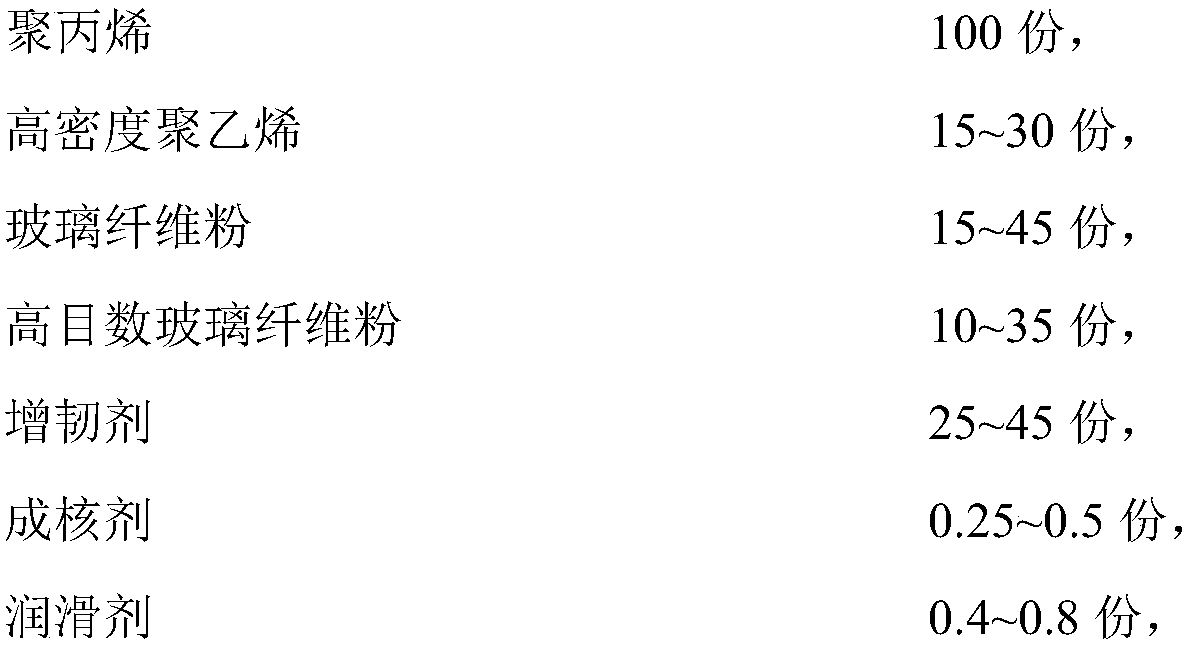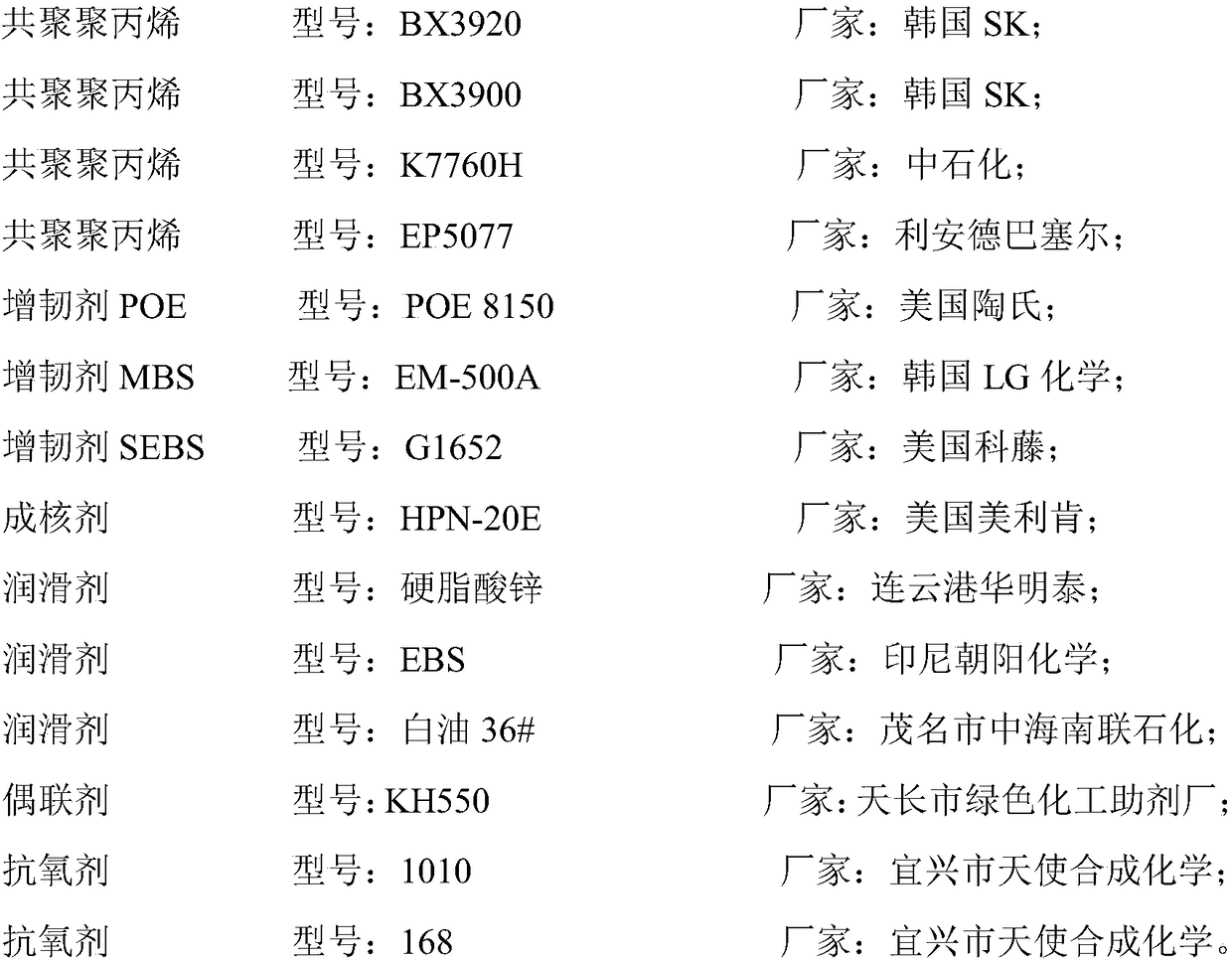Low after-shrinkage polypropylene composite and preparation method thereof
A composite material and polypropylene technology, which is applied in the field of low post-shrinkage polypropylene composite material and its preparation, can solve the problems of easy shrinkage and the size of parts, and achieve the effects of easy mass production, reduced shrinkage rate and simple process
- Summary
- Abstract
- Description
- Claims
- Application Information
AI Technical Summary
Problems solved by technology
Method used
Image
Examples
Embodiment 1
[0034] The first step: Weigh 15 parts of glass fiber powder in high-speed mixer A, then add 0.08 parts of lubricant zinc stearate and 0.12 parts of lubricant ethylene bis stearic acid amide and mix for 20 minutes to obtain mixture A; then take out the mixture 2 / 5 of the total weight of A is reserved; then weigh 10 parts of 8000-mesh glass fiber powder and continue mixing in high-speed mixer A for 20 minutes to obtain mixture B; wherein the speed of high-speed mixer A is 200 rpm, and the temperature is 50°C .
[0035] Step 2: Weigh 60 parts of polypropylene BX3900, 40 parts of polypropylene EP5077, 15 parts of high-density polyethylene, 15 parts of toughening agent POE 8150, 7 parts of toughening agent EM-500A, and 3 parts of toughening agent SEBS G1652 in In high-speed mixer B, add 0.25 parts of nucleating agent HPN-20E and 0.2 parts of coupling agent KH550 and mix for 20 minutes to obtain mixture C; the speed of high-speed mixer B is 200 rpm, and the temperature is 50°C.
[...
Embodiment 2
[0039] The first step: Weigh 45 parts of glass fiber powder in high-speed mixer A, then add 0.21 parts of lubricant zinc stearate and 0.19 parts of lubricant ethylene bis stearic acid amide and mix for 30 minutes to obtain mixture A; then take out the mixture 2 / 5 of the total weight of A is reserved; then weigh 35 parts of 11000-mesh glass fiber powder and continue mixing in high-speed mixer A for 30 minutes to obtain mixture B; wherein the speed of high-speed mixer A is 300 rpm and the temperature is 70°C .
[0040] Step 2: Weigh 58 parts of polypropylene BX3920, 42 parts of polypropylene EP5077, 30 parts of high-density polyethylene, 30 parts of toughening agent POE 8150, 10 parts of toughening agent EM-500A, and 5 parts of toughening agent SEBS G1652 in In high-speed mixer B, add 0.5 parts of nucleating agent HPN-20E and 0.3 parts of coupling agent KH550 and mix for 30 minutes to obtain mixture C; the speed of high-speed mixer B is 300 rpm, and the temperature is 70°C.
[...
Embodiment 3
[0044]The first step: Weigh 21 parts of glass fiber powder in high-speed mixer A, then add 0.09 parts of lubricant zinc stearate and 0.17 parts of lubricant ethylene bis stearic acid amide and mix for 23 minutes to obtain mixture A; then take out the mixture 2 / 5 of the total weight of A is reserved; then weigh 12 parts of 11000-mesh glass fiber powder and continue mixing in high-speed mixer A for 27 minutes to obtain mixture B; wherein the speed of high-speed mixer A is 234 rpm and the temperature is 57°C .
[0045] Step 2: Weigh 43 parts of polypropylene K7760H, 57 parts of polypropylene EP5077, 19 parts of high-density polyethylene, 19 parts of toughening agent POE 8150, 7 parts of toughening agent EM-500A, and 5 parts of toughening agent SEBS G1652 in In high-speed mixer B, add 0.29 parts of nucleating agent HPN-20E and 0.24 parts of coupling agent KH550 and mix for 24 minutes to obtain mixture C; the speed of high-speed mixer B is 209 rpm, and the temperature is 59°C.
[...
PUM
| Property | Measurement | Unit |
|---|---|---|
| shrinkage | aaaaa | aaaaa |
Abstract
Description
Claims
Application Information
 Login to View More
Login to View More - R&D
- Intellectual Property
- Life Sciences
- Materials
- Tech Scout
- Unparalleled Data Quality
- Higher Quality Content
- 60% Fewer Hallucinations
Browse by: Latest US Patents, China's latest patents, Technical Efficacy Thesaurus, Application Domain, Technology Topic, Popular Technical Reports.
© 2025 PatSnap. All rights reserved.Legal|Privacy policy|Modern Slavery Act Transparency Statement|Sitemap|About US| Contact US: help@patsnap.com



